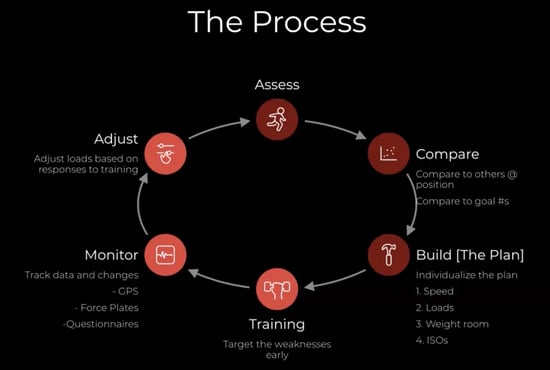My Speed Training Process
I got on a plane in Miami at 5:40.
I landed at midnight with my daughter.
I got 4 hours of sleep.
Woke up with a nail in my tire so I had to flip cars.
Already, we’re starting the day off in a struggle.
On top of that, it was the biggest grind day for combine training so far.
We have two groups, and in those two groups there are 3 new athletes which means there are tons of layers that are happening on a day like that.
That’s where I thought, you really fall to the level of your systems.
As much planning as we did, it’s your systems that are going to uphold what you had planned or what falls.
Today, I’ll share a little bit more about the system we use. Let’s dive in…
Our Speed Training Process
If you fall to the level of your system, your system better be airtight.
Over my entire career this is something that I’ve been iterating on and improving to get it to where it is today.
Before walking through our process, I love this quote:
“Time needs to be invested into figuring out what change is necessary or favorable rather than jumping to predetermined movement template”
Essentially, this means you can’t give everybody the same thing. If I give everyone the same stimulus, ⅓ will get better, ⅓ will stay the same, and ⅓ will get worse, which to me, is unacceptable.
I share this because our system takes this into account. It’s a process we go through with every athlete, each by inputting their own variables, data, and training level.
We use the same process for every athlete, whether it’s combine, college, our soccer athletes, etc. For today’s sake, I’ll talk about it in relation to the combine.
Here it is:

1. Assess - we always start with an assessment
For combine we use 4 assessments: Force Frame, NordBord, Force Plate jumps, and Force & Load velocity profiles on the 1080.
2. Compare - according to positions and goals.
So if we have a receiver, we would compare them to other receivers but also to their goals coming in. If he runs a 4.5 and wants to run a 4.3, what do the other 4.3 guys look like? We have enough data in our database to determine where he’s at compared to the past results.
3. Build the Plan - four ways we individualize the plan
Speed: We have a small enough group where we could manipulate the session to individualize each athlete's focus. So if we wanted someone to focus more on backend of the 40 or more of the start, we can get really specific here.
Loads: We use the 1080 for loading, which can be very specific for each athlete. Heavy, light, resisted, assisted, we consistently manipulate the loads specific to the athlete’s needs.
Weight Room: Our weight room is extremely targeted. Certain guys need to be able to produce more force, some need to be more elastic, others are doing more facial stuff. Again, it’s all individualized.
Isos: This will be very similar to above, specific to the athlete’s need.
4. Train - target weaknesses early
Furthest away from combine we attack the weaknesses. So week 0, week 1 that’s what we focused on.
5. Monitor - track data w/ gps, force plates, questionnaires
GPS: We use Catapult for this every single day to monitor loads and see if our athletes are doing too much or too little.
Force Plates: We’ll jump on all speed days and occasionally on non-speed days to see where athletes are at. Basically we’re trying to find out if their nervous system is producing force fast, and asking are they ready to run fast?
Questionnaires: We have a questionnaire in morning and evening, to understand if athletes are ready to go and prepared beforehand, and then to see how hard the session was afterwards.
6. Adjust - adjust loads based on response to training
Finally, we adjust training based on a number of factors. What we’re seeing from monitoring the data, what we see in their performance, adjust based on risk, etc. If a guy comes to us and he’s red flagged on force plates, or on volume, we may pull him back a little bit during that day so that he’s not overloading a quality.
–
From here, it jumps back to the assessment. That’s our process!
It is a continuous process, not just a one-time thing which is important to remember.
Having this in place is such an important aspect of what we do, especially on days where outside factors seem to be falling apart.
Remember, you fall to the level of your systems.
P.S. If you want to learn how to build this system in your own training environment, check out our digital speed courses.